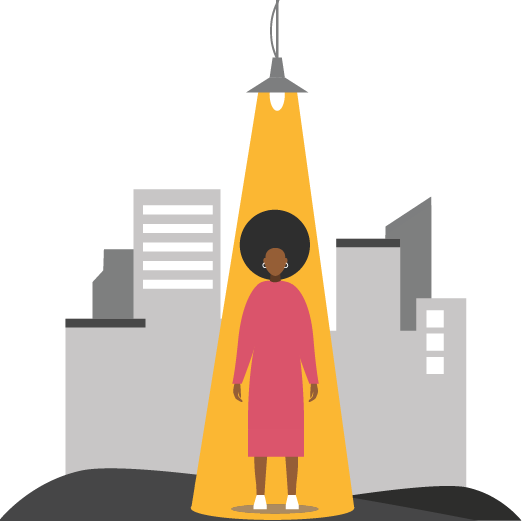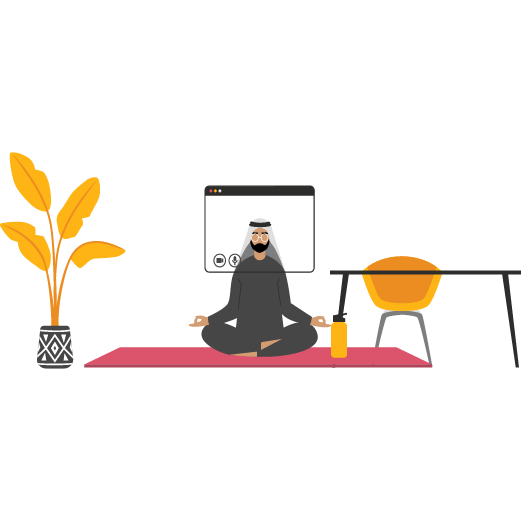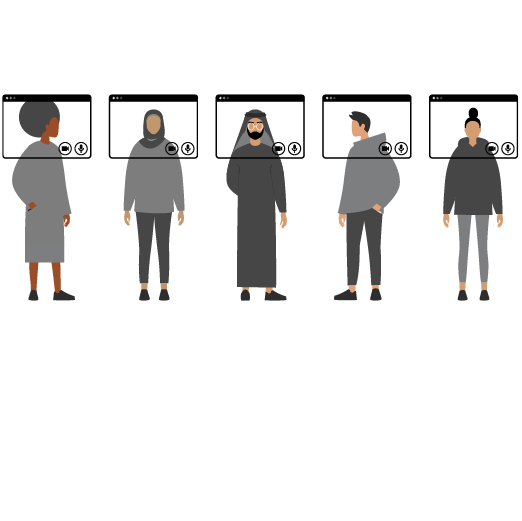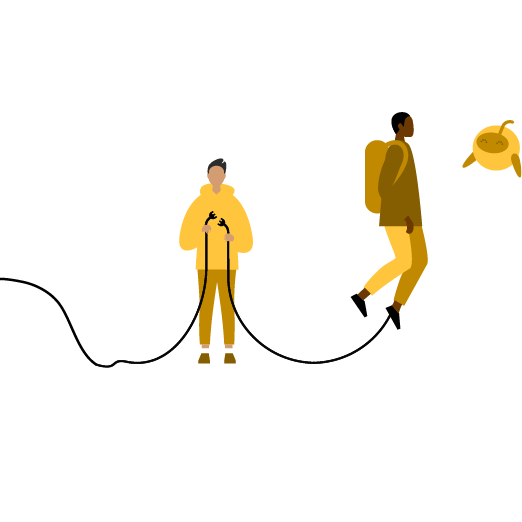Why HR matters now more than ever?
The COVID-19 pandemic has disrupted global economies and businesses, and Human Resources (HR) has been at the heart of it. With organisations now on the cusp of recovery, the role of HR is becoming even more important.
- How will the outlook on occupational health and safety change as a result of COVID-19?
- How will the introduction of remote working affect organisational culture and day-to-day operations?
- What are the social implications of such a transformation on employee engagement and communication?
The questions are endless when it comes to envisioning the future impact and role of HR post-COVID-19. One thing is for certain – the pandemic and its inherent effect on businesses has highlighted the need for adaptability and resilience in today’s workforce, accelerated the shift towards a new, digital economy and accentuated the importance of HR in the new normal.

Redefining the organisation
Redefining organisational culture by shifting towards a people-centric workplace
Re-establishing organisational culture will become a top priority for HR departments as organisations look to adopt more flexible working arrangements. There will likely be a major shift towards hybrid working models that capitalise on the benefits of both remote and office working. While this is a positive change, the implications of this transition threaten the existing organisational culture. The social dynamic between employees will no longer be the same due to varying working conditions, such as less face-to-face interaction and an increasingly dispersed workforce. How will business leaders guide the actions and influence the decisions of employees at all levels?
Organising regular check-ins exclusively for work, social interaction, or emotional support is a great way to establish a balanced structure suited to managing a remote workforce and to strengthen relationships. Promoting open dialogue and installing direct communication channels between all levels within an organisation will help keep leadership informed of employee concerns. Finally, introducing diversity, equality, and inclusion policies and programmes will help bolster organisational culture and create an environment that promotes trust, unity, empathy, and engagement. As organisations look to accelerate the pace of remote working in the foreseeable future, it is essential that they make a conscious effort to preserve their core values and emphasise building a workplace that puts people at the forefront of every decision. Most importantly, focusing on employee engagement through pulse and satisfaction surveys is a great way to gauge their experience and ideas, and get their recommendations on how best to transition to the new normal.

Introducing new structures to enhance workforce flexibility and productivity
Given the recent success of remote working, organisations will be looking to capitalise on productivity and efficiency gains by establishing a hybrid working model that supports both office and remote working. HR needs to support businesses in redesigning organisational structures and job roles to accommodate the new normal, with high emphasis on promoting operational efficiency. There will likely be a major shift towards highly flexible organisational structures that allow for the effective redeployment of workers. This means designing organisations that are scalable and highly adaptive to future uncertainties.
HR is also increasingly playing an integral role in reskilling existing employees. COVID-19 has led to large-scale competency mapping and will likely result in many employees being redeployed to other divisions that have or will have demand. As a result, it is critical that redeployed workers are equipped with the necessary skills that will enable them to seamlessly transition into their new roles. Moving forward, job roles and functions will increasingly be designed for those with transferable skills who can apply them in a broader context. Additionally, offering flexible working arrangements by introducing staggered hours, flextime, or flexplace will help employees improve their work-life balance, while also allowing organisations to capitalise on the increased workforce productivity and efficiency.

Maximising occupational health and safety by focusing on physical and mental well-being
As employees look to return to the workplace, HR must consider introducing the necessary measures to ensure employee safety and wellbeing. This includes focusing on physical wellness, as well as the emotional and mental aspects of wellbeing. In addition to implementing social distancing measures, installing sensor based technologies throughout the workplace is a great way to minimise physical contact and reduce the risk of spreading the virus. Moreover, many employees – particularly those who have been the victims of downsizing and restructuring initiatives – are likely enduring high levels of stress and anxiety due to the disruption the pandemic has inflicted on their day-to-day lives. HR has an ethical and moral obligation to all those that have been impacted by COVID-19. As such, they must take the lead in providing displaced workers with outplacement and career transitioning services such as counseling and assistance in identifying career opportunities. In conclusion, HR should assist all workers, past and present, by establishing mental wellness programmes, offering around the clock support to those who need it and raising awareness by disseminating

Driving people transformation
Realigning rewards to market realities through adaptive and personalised compensation structures
The impact of COVID-19 has left many businesses with considerable debt levels, surging costs, little to no revenue, and weakened balance sheets. As such, they have been forced to take measures to cut costs by temporarily deferring or reducing employee compensation and benefits. While this may dictate many organisations’ short term strategies, the pandemic has also opened the discussion around rethinking employee rewards and benefits in the long term.
Many organisations will be looking to attract and compete for top talent to help steer the ship towards a swift and successful post-COVID recovery. Since many employers may not be able to offer higher salaries, they may look at reducing fixed pay while increasing variable pay that is directly linked to employee performance and productivity. This helps incentivise employees to perform at a higher level while maintaining a healthy and competitive environment. On the other hand, some organisations may consider taking the alternative route of offering flexible compensation and benefits packages that could give them a competitive edge. Another possibility is to introduce personalised compensation structures that allow employees to design their own packages that are more suited to their needs and preferences.

Reassessing performance and succession management to complement an agile and dynamic workforce
The COVID-19 pandemic has pushed many workers to take on a wide variety of roles and responsibilities. Remote working has completely changed the way we work and some employees may experience a learning curve before managing the same level of efficiency as before the pandemic. As such, employers should take this into account when it’s time for performance evaluations. Moreover, HR may consider transitioning to an outcome-based performance management system where employees’ performance is measured solely on their outputs rather than the time spent working. This means rethinking and realigning KPIs to match new realities and accommodate the transition towards the new normal as employees gradually upskill and reskill themselves.
Many employers will also look at introducing performance monitoring technologies to track employee performance and outputs, and HR will play a key role in ensuring they are successfully implemented. Furthermore, HR may consider focusing on succession planning efforts by identifying and re-assessing critical roles, establishing emergency plans through scenario based planning rather than traditional HR planning, ensuring they have the right people in place to take over, and communicating these plans effectively to ensure employee readiness when the time comes.

Reinforcing the learning and development agenda through digital upskilling
Learning and development is rapidly becoming an integral part of the HR agenda, with a prime focus on ensuring organisations are ready for life post-COVID-19. HR should consider upskilling their current workforce with transferable and unique skills that give them a competitive edge and make them more resilient to change. These skills give employees the ability to be redeployed elsewhere while maintaining current levels of utilisation. In turn, this also diminishes the need for organisations to take abrupt and unnecessary measures such as forced leaves, layoffs, and salary cuts.
COVID-19 has accelerated the digital transformation of organisations around the world, with employees being forced to work remotely and resort to different technologies to deliver their work. While digital upskilling is becoming an integral part of many organisations’ learning and development agendas, according to PwC’s Hopes and Fears Survey in the GCC, only 23% of workers are learning new skills through their employer to better understand or use technology.1 HR must consider implementing effective programs to ensure employees are equipped with the necessary digital skills and tools needed to succeed in today’s workforce.

Enabling change
Leveraging workforce analytics to promote data-driven decision making
Over the last decade, we have witnessed a rise in data-driven decision making across all industries, business sectors and organisations, and HR is no different. Workforce analytics enables HR to gauge employee experience, engagement, and satisfaction. In an effort to stay competitive in the modern and complex business landscape, particularly as a result of COVID-19, organisations should continue to leverage analytics to forecast their workforce requirements and to better optimise revenues and reduce costs. They should also become more reliant on analytics to measure and monitor workforce performance and productivity. By regularly analysing and monitoring employee performance and engagement metrics, HR can determine the strategic talent acquisition, development and management decisions required to prepare the workforce for the challenges they will face post COVID-19.

Rethinking talent sourcing and recruitment by embracing emerging technologies and diverse skill sets
Organisations are now looking to redefine their recruitment strategies in an effort to shift towards a more cost-efficient and effective operating model. This means hiring individuals with transferable skills, who can provide a more forward-looking outlook and thrive in an ever-changing environment. The skill sets and competencies needed to succeed in today’s workplace are constantly evolving with employers now more likely to hire tech-savvy candidates who offer more adaptability and flexibility. Employers may also consider delving into the gig economy by hiring subcontractors or contingent workers, who offer a cost effective alternative to full-time employees. As such, it is crucial that individuals focus on digitally upskilling themselves or risk falling behind.
Organisations should consider reimagining their recruitment and sourcing strategies to capitalise on their inherent productivity and efficiency gains. The rise and success of remote working has paved the way for alternative recruitment and sourcing strategies, such as conducting the entire recruitment process from planning and talent sourcing to assessing, selecting, hiring, and onboarding in a virtual environment. Emerging technologies, such as artificial intelligence (AI), virtual reality (VR), augmented reality (AR) and blockchain, in conjunction with data science, are driving the automation and digitalisation of HR functions – potentially making more decisions free of implicit bias and laying the foundation for highly equitable decision making processes across organisations. Will blockchain technology be used for conducting background checks where employers can virtually acquire immutable applicant credentials and historical records? Will employers look to hire full-time workers from abroad and have them permanently stationed in a different territory? Or will we only recruit locally in anticipation of a possible future pandemic and travel restrictions? Only time will tell.

Accelerating the digital transformation agenda through the integration of disruptive technologies
Digital transformation has become an increasingly hot topic and has posed questions around the role of HR moving forward. Businesses are now looking to reduce costs by any means, putting HR under pressure to create more value with less resources. 62% of Middle East CFOs and 59% of UAE CFOs are looking to accelerate the adoption of automation and establish new ways of working once they begin to transition back to the workplace, with 50% citing this globally.2 As such, HR is being pushed to take on a more strategic role within organisations. This includes downsizing HR itself by cutting redundant operational and compliance related jobs and automating these functions instead, enabling organisations to push the boundaries of operational efficiency even further. Even more so, emerging technologies, such as AI, VR, and AR, have opened the door for a wide variety of applications in the HR domain. These technologies will help improve all HR functions including recruitment, onboarding, training, and so much more. For instance, through data science and AI applications, organisations are now able to extensively reduce the hiring cycle by using a fully automated CV screening process which completes several days or even weeks worth of work in a matter of minutes. Big data and data analytics enhance the recruitment process by helping identify top talent as well as forecast workforce capability and capacity requirements. AR and VR technologies will be used to improve the onboarding process through virtual office tours, no longer requiring new hires to be physically present. Similarly, reskilling and upskilling of employees through virtual and digital learning platforms will soon become a reality, meaning that organisations will no longer need to invest in the infrastructure and logistics necessary for ‘live’ training.

The world is evolving and HR with it
Due to the pandemic’s effect on the economy, organisations were quickly forced to transform and adapt to the new normal in order to survive. It is vital that HR evolves and transforms across every element of the HR lifecycle to meet a new set of organisational needs. Simply put, HR will need to increasingly find ways to support business leaders in restructuring during and after the pandemic, take workforce rationalisation measures while managing risks associated with such interventions, and increase productivity and employee engagement. After all, the COVID-19 pandemic will most likely be with us well into 2021, so we need to learn to live with it. It’s essential to act now – the more HR lags behind, the more time it will take for organisations to adapt and succeed in the post-COVID era.
1 “New world. New skills. Insights from the GCC Hopes and Fears survey,” PwC Middle East, 2020, https://www.pwc.com/m1/en/issues/pdf/new-world-new-skills-gcc-2020.pdf
2 “PwC’s COVID-19 CFO Pulse Survey – 4th edition. Middle East Findings,” PwC Middle East, June 16, 2020, https://www.pwc.com/m1/en/publications/covid-19/CFO/pwc-middle-east-covid-19-cfo-pulse-survey-4th.pdf
This article was first published here.
Photo by Jared Arango on Unsplash.

 4.0
4.0 





















